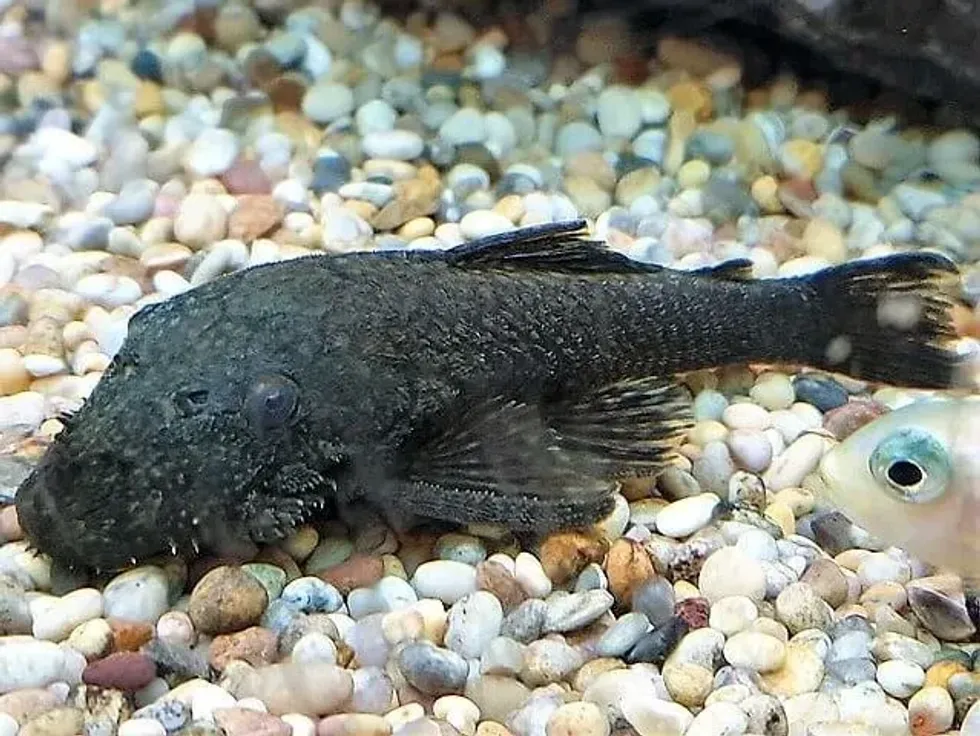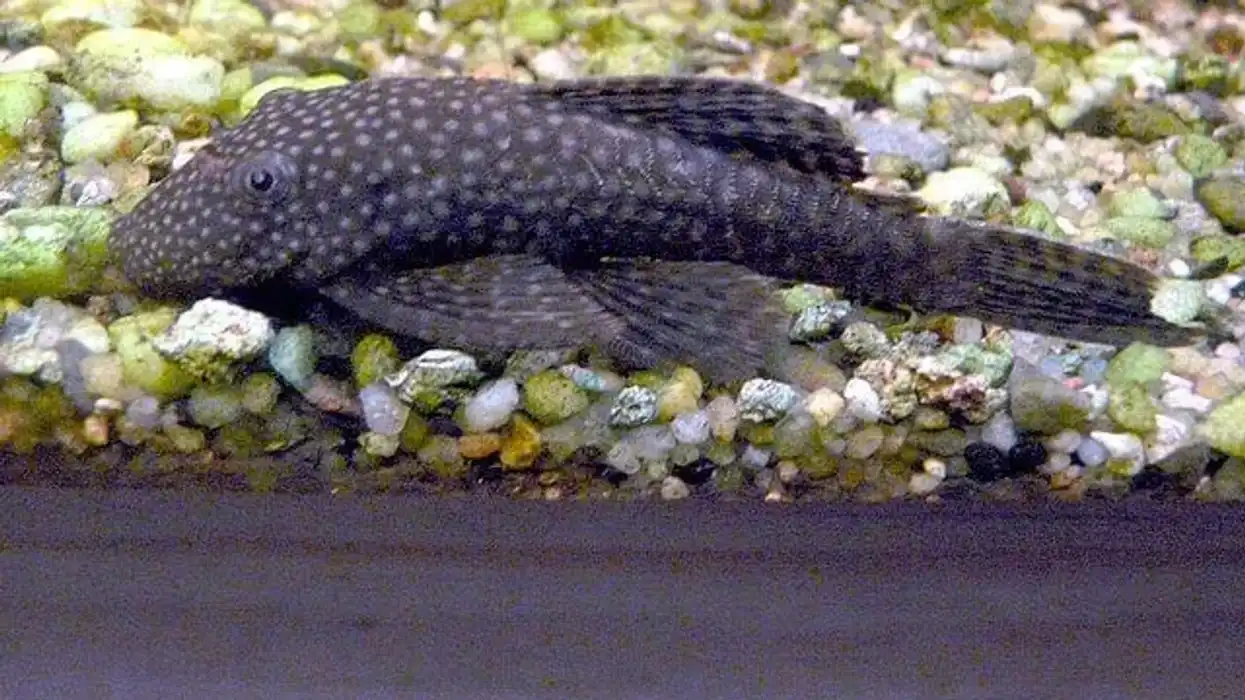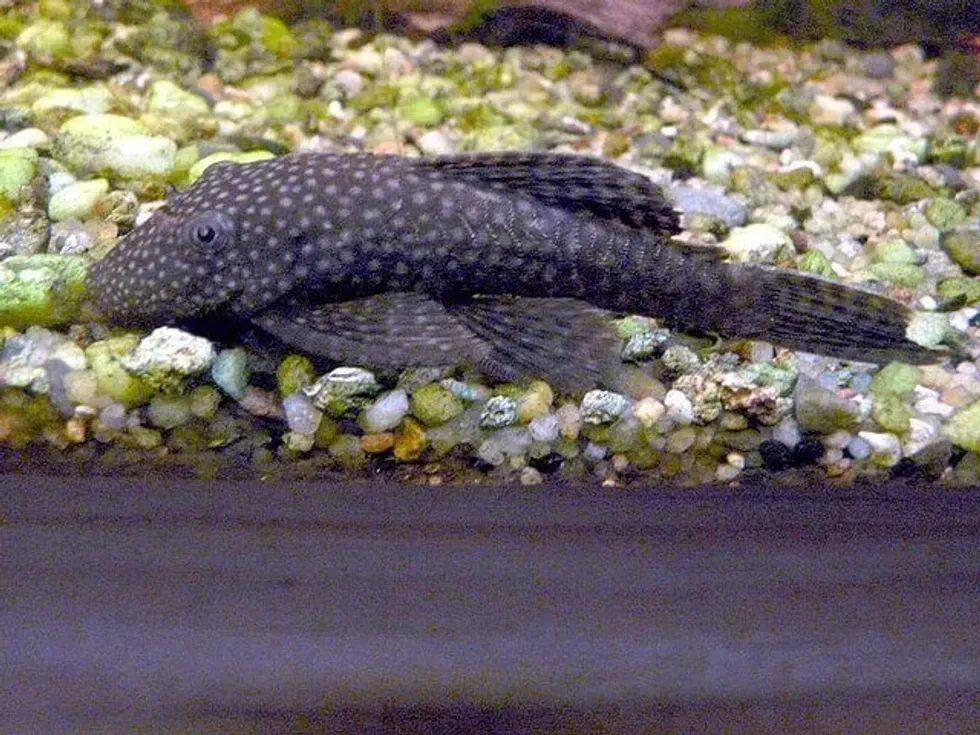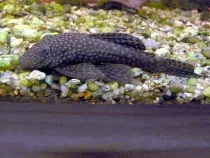Fun Bushymouth Catfish Facts For Kids

A species of the Ancistrus genus, the bushymouth catfish (Ancistrus dolichopterus) is an armored catfish that originates in Brazil. The species is found in the middle of the Amazon River Basin and the basins of lower Trombetas, the Tete, the Medeira, the Tapajos Rivers, and the Rio Negro.
The freshwater fish is known by several names: bristlenose pleco, bristlenose catfish, and bushynose catfish.
The bristlenose pleco has a flat plain body completely covered with polyangular boney plates. The head is wider, the body is thick, flat, and shorter, compared to other plecos.
The species is found in several variants: a blend of a black, brown, gray, or olive base with paler orange, white, or yellow spots on the body.
Along the back, bristlenose plecos possess a dorsal fin while strong pectoral and abdominal fins help them to travel at the bottom of the tank. The average length of bristlenose pleco is around 3-6 in (8-15 cm), making it the smallest catfish.
Species of bristlenose pleco are found in freshwater habitats of shallow, fast-moving rivers, and streams of tropical South America. These bottom-dwellers are found behind the piles of woods that help them to prey on biofilm, algae, vegetation, fish eggs, and aquatic crustaceans such as brine shrimp.
The bristlenose plecos are generally kept in fish tanks where the pH range is between 6.5-7.5. Tanks of 20-25 gal (76-95 l) generally suit them. The International Union for Conservation of Nature listed the species in the Least Concern category. Predation is considered the only major threat to the species of bristlenose pleco.
Keep on reading to learn more interesting facts about the bushymouth catfish. If you want to know more exciting information about different animals, check out these channel catfish facts and cory catfish facts.
Bushymouth Catfish Interesting Facts
What type of animal is a bushymouth catfish?
The bushymouth catfish (Ancistrus dolichopterus) is an omnivorous fish species of the Ancistrus genus. The fish is a bottom-dweller found behind the piles of woods that help them prey on biofilm, algae, vegetation, fish eggs, and aquatic crustaceans such as brine shrimp.
What class of animal does a bushymouth catfish belong to?
The bushymouth catfish belongs to the order of Siluriformes, the class of Actinopterygii, the family Loricariidae, and the Ancistrus genus. The freshwater fish is known by several names: bristlenose pleco, bristlenose catfish, and bushynose catfish.
How many bushymouth catfish are there in the world?
The exact population of bristlenose plecos is not known as of now, but the Ancistrus is known as of the widest-ranging genera of the Loricarridae family. Many fish species are found in the rivers and floodplain areas of the Amazon Basin, while several species are found in the tropical regions of South America.
Where does a bushymouth catfish live?
The bristlenose catfish is found in the middle of the Amazon River Basin and the basins of lower Trombetas, the Tete, the Medeira, the Tapajos Rivers, and the Rio Negro. Also, the related species are widely distributed within a 667 million ac (270 million ha) region, also known as the Guiana Shield.
The fish can easily be spotted in countries such as Brazil, Venezuela, Panama, Guyana, Columbia, and many more.
What is a bushymouth catfish's habitat?
Species of bristlenose pleco are found in freshwater habitats of shallow, fast-moving rivers, and streams of tropical South America. These bottom-dwelling catfish are found behind the piles of woods. Since the brushmouth pleco is a beautiful species, tanks also serve as a habitat.
Who do bushymouth catfish live with?
Very little information regarding the behavior of the fish species is available as of now, but these bottom-dwellers are nocturnal and remain active during the night. Also, these fish are quite peaceful and can survive with several tank mates in the community tank.
How long does a bushymouth catfish live?
The bristlenose plecos can easily live for around 12 years, they are hardy fish and can easily tolerate a wide range of water conditions. Also, the life span could even increase if kept in captivity and studies reveal that they are compatible with numerous freshwater fish.
How do they reproduce?
The fish follow similar methods of reproduction as other fish. The breeding patterns are generally very simple and a normal tank would be an ideal habitat for it. People generally add caves, plants, or driftwood to the habitat that would encourage breeding. These fish generally attain sexual maturity after one year of age.
Also, several courtship displays are performed, the most common is the stylized flight. Males generally poke and push females to grab their attention. In return, females twitch and move away; males always try to move females more and more to the breeding caves. Also, males are quite territorial and they generally claim the territory after becoming mature.
The natural breeding season generally occurs during the rainy season of the Amazon region, thus the water of the tank should be changed during the month of November to spur mating behaviors, people generally change 75% of the water and decrease the water temperature by 35.6 F (2 C) to promote breeding.
Through the plumpness of females, one can recognize that they are ready to mate and they generally spawn or mate every four to eight weeks.
Females generally lay 50-200 eggs in the territory of males and eggs are stuck hard surfaces such as caves, driftwood, and PVC pipes. The male fish protects the spawning area for a week or two and protects the eggs until they hatch.
What is their conservation status?
The International Union for Conservation of Nature classified the species in the Least Concern category, studies reveal that the population of the species is stable and predation is the only major threat faced by them in the wild.
Bushymouth Catfish Fun Facts
What do bushymouth catfish look like?
The bristlenose pleco has a flat plain body completely covered with polyangular boney plates. The head is wider, the body is thick, flat, and shorter, compared to other plecos.
The species is found in several variants: a blend of a black, brown, gray, or olive base with paler orange, white, or yellow spots on the body. Along the back, bristlenose plecos possess a dorsal fin while strong pectoral and abdominal fins help them to travel at the bottom of the tank.

How cute are they?
Since the bristlenose pleco is an aquarium fish, it becomes very easy for us to see the fish from a closer distance. The colorful spots are very fascinating, also the fat body resembles an umbrella. The peaceful nature of the fish makes it more adorable, one would love to watch the fish feeding on algae with other tank mates.
How do they communicate?
Like other fish, the bushymouth catfish uses similar methods to communicate with each other. Fish generally communicate through the sense of smell, touch, and skin darkening, and many more.
During the breeding season, the male bushymouth catfish generally nudges and pushes the female to grab the attention, while through the plumpness of females, one can recognize that they are ready to mate.
How big is a bushymouth catfish?
The average length of bristlenose pleco is around 3-6 in (8-15 cm), making it the smallest catfish. These fish are thrice the size of white cloud mountain minnow fish, while some of them are bigger than the round goby.
How fast can a bushymouth catfish swim?
The exact speed of a bushymouth catfish is not as of now but an adult catfish can easily swim at a speed of 2.23 mph (3.6 kph). The male fish is quite territorial and generally defends the territory with agility. Also, the fish species is nocturnal and remains active to avoid predation.
How much does a bushymouth catfish weigh?
The exact weight of the bristlenose pleco fish is not known as of now. The fish is considered the smallest species of catfish.
What are their male and female names of the species?
There are no specific names given to the male and female bushymouth catfish. Unlike the female, the male fish is larger and has whiskers and larger bristles. The male fish has bristles on the head while bristles can be seen on the snouts of the female. The female has no spikes on its fins.
What would you call a baby bushymouth catfish?
Terms such as alevin or juvenile are used to refer to the baby of bushymouth catfish.
What do they eat?
The bristlenose plecos are usually referred to as algae eaters as they primarily feed on algae. These fish occasionally prey on small crustaceans such as shrimps. Also, in aquariums and community tanks, people often feed them granules, flakes, bloodworms. Zucchini slices and blanched lettuce and spinach could also be included in the bristlenose pleco diet.
Are they dangerous?
Generally, bristlenose plecos are not dangerous and pose no serious threats to humans. The male bushymouth catfish are generally territorial and could attack if someone tries to threaten their partner and eggs.
Would they make a good pet?
The bristlenose plecos are regarded as great fish for aquariums. Since they are quite peaceful and social, they go well with several algae eaters.
But several things should be kept in mind before keeping them such as the aquarium size, water conditions. These fish can easily survive in tanks of more than 20 gal (76 l). They can also handle different water conditions such as acidic, alkaline, and harder.
Also, algae should be provided once or twice a day. Along with them, granules, flakes, bloodworms, zucchini slices, blanched lettuce can also be fed.
Did you know...
When the length of a catfish reaches 4 in (10 cm), the fish is known as a fingerling. These fish have around 27,000 tastebuds.
The Mekong giant catfish is the biggest species of catfish, the fish weighs around 650 lb (295 kg) and is 106.3 in (2.7 m) long.
The bushymouth catfish is not endemic to a particular region.
The bristlenose plecos are herbivores but do not harm live plants.
Are bristlenose catfish aggressive?
The bristlenose plecos are regarded as peaceful and social fish, they make great inhabitants of community tanks. These fish can easily survive with other algae eaters such as snails and grazing fish.
Species such as neon tetras, guppies, platys, and many more make good partners. But male bristlenose plecos are quite aggressive and territorial and go to any extent to protect the eggs and juveniles.
Can you keep bristlenose catfish in cold water?
Generally, the bristlenose pleco is found in freshwater habitats of shallow, fast-moving rivers, and streams of tropical South America. Also, several hard surfaces such as roots, plants, driftwood, caves are needed for them to hide.
Their breeding season majorly occurs in November and people generally reduce the temperature of the water to promote spawning.
More than 50% of the 77 F (25 C) tank is replaced by 50 F (10 C) water. Also, one needs to keep in mind that the temperature reduction should not harm the other inhabitants of the tank or aquarium.
Here at Kidadl, we have carefully created lots of interesting family-friendly animal facts for everyone to discover! For more relatable content, check out these clown triggerfish facts and golden tetra facts pages.
You can even occupy yourself at home by coloring in one of our free printable bushymouth catfish coloring pages.
We Want Your Photos!
More for You
See All
Bachelor of Arts specializing in History

Abhishek MishraBachelor of Arts specializing in History
As a content writer, Abhishek's passion for writing extends beyond professional content creation. With a Bachelor's degree in History from Ram Lal Anand College in Delhi, Abhishek is a skilled writer in both English and Hindi, bringing a creative flair to his work. He enjoys crafting satires and poetry and is dedicated to producing engaging and informative content.
Bachelor of Commerce specializing in Marketing and HR

Pradhanya RaoBachelor of Commerce specializing in Marketing and HR
With a Bachelor’s degree in Commerce from Christ University, Bangalore, Pradhanya's passion for the English language and literature led her to explore the field of content writing, where she has gained extensive experience in writing, reviewing, editing, and fact-checking. She has also earned certifications in Google Ads Search, Google Ads Display, and Social Media Marketing, showcasing her proficiency in digital marketing.
Disclaimer
1) Kidadl is independent and to make our service free to you the reader we are supported by advertising. We hope you love our recommendations for products and services! What we suggest is selected independently by the Kidadl team. If you purchase using the Buy Now button we may earn a small commission. This does not influence our choices. Prices are correct and items are available at the time the article was published but we cannot guarantee that on the time of reading. Please note that Kidadl is a participant in the Amazon Services LLC Associates Program, an affiliate advertising program designed to provide a means for sites to earn advertising fees by advertising and linking to Amazon. We also link to other websites, but are not responsible for their content.
2) At Kidadl, we strive to recommend the very best activities and events. We will always aim to give you accurate information at the date of publication - however, information does change, so it’s important you do your own research, double-check and make the decision that is right for your family. We recognise that not all activities and ideas are appropriate for all children and families or in all circumstances. Our recommended activities are based on age but these are a guide. We recommend that these ideas are used as inspiration, that ideas are undertaken with appropriate adult supervision, and that each adult uses their own discretion and knowledge of their children to consider the safety and suitability. Kidadl cannot accept liability for the execution of these ideas, and parental supervision is advised at all times, as safety is paramount. Anyone using the information provided by Kidadl does so at their own risk and we can not accept liability if things go wrong.
3) Because we are an educational resource, we have quotes and facts about a range of historical and modern figures. We do not endorse the actions of or rhetoric of all the people included in these collections, but we think they are important for growing minds to learn about under the guidance of parents or guardians.







